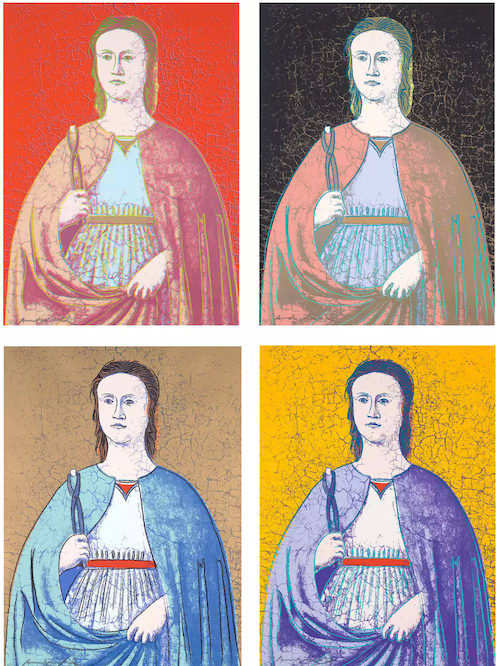
Andy Warhol
76.2 x 55.9 cm
Andy Warhol’s Saint Apollonia portfolio, created in 1984, draws inspiration from a 15th-century panel painting attributed to the workshop of Piero della Francesca, dated circa 1470. The subject, Saint Apollonia, is venerated in Christian tradition as the patron saint of dentistry—martyrdom accounts describe her teeth being violently extracted with pincers, an image that endures in her iconography.
Though Warhol’s legacy is most commonly associated with celebrity culture, consumer goods, and Pop Art’s brash irreverence, he was also a devout Catholic whose faith increasingly informed his work in the later stages of his career. His religious devotion coexisted with his identity as a gay man—a complex duality that permeates many of his more contemplative series. With Saint Apollonia, Warhol turns his attention to sacred subjects and explores themes of martyrdom, veneration, and spiritual symbolism, rooted in the Byzantine Catholic tradition of his youth. As a child, Warhol regularly attended the St. John Chrysostom Byzantine Catholic Church in Pittsburgh, where gilded icons and ceremonial aesthetics likely planted the seeds for his lifelong fascination with religious imagery.
Unlike many of his other reinterpretations of Renaissance works, Saint Apollonia is handled with notable reverence and restraint. While Warhol’s typical style includes bold color overlays and intentionally off-register silkscreening, here he opts for fidelity to the original. The prints maintain the central composition of the Francesca panel, including the worn texture and aged "cracks" of the five-century-old painting. The color palette, though still distinctively Warholian, is comparatively subdued—muted tones replace the saturated vibrancy often found in his portraits of celebrities or political figures.
The complete portfolio consists of four screenprints: FS II.330, 331, 332, and 333. Each version explores subtle shifts in tone, layering, and emotional resonance, yet all remain anchored in the original image’s composition. Warhol does little to crop or distort the subject. Instead, he treats the figure of Saint Apollonia with a sense of solemnity, preserving her quiet dignity and ethereal presence.
Saint Apollonia forms part of a broader body of religiously inspired work that Warhol developed later in his career. While early Pop masterpieces like Marilyn Diptych and Campbell’s Soup Cans captured the secular icons of postwar America, his religious works reflect a deepening introspection and an evolving dialogue with art history. This spiritual turn is also evident in portfolios such as Details of Renaissance Paintings, The Birth of Venus, The Annunciation, and St. George and the Dragon. In each, Warhol bridges the sacred and the contemporary, the canonical and the commercial.
His treatment of Saint Apollonia is perhaps the most respectful and directly referential of all. Unlike other reinterpretations where he fragmented, distorted, or glamorized his subjects, here Warhol assumes the role of custodian rather than provocateur. The preservation of the panel’s structure, including the illusion of age, suggests a conscious homage—not only to della Francesca’s workshop but to the entire tradition of Christian devotional art.
Today, the original painting of Saint Apollonia resides in the National Gallery of Art in Washington, D.C., while Warhol’s portfolio lives on as a striking and unexpected chapter in his artistic journey—one that underscores the depth and complexity of his personal faith, and his enduring fascination with the visual power of icons, whether sacred or secular.
For more information on Andy Warhol’s complete Saint Apollonia portfolio for sale or to buy the complete Saint Apollonia set contact our galleries using the form below.